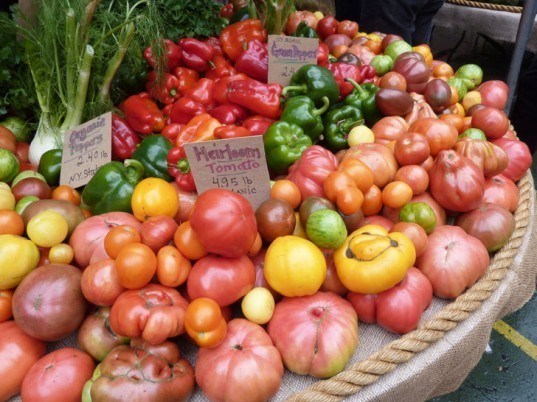Trying to choose which heirloom tomatoes you want to grow can be bewildering.
When you look at a catalogue you’ll find dozens of tempting varieties in a range of colours.
The following basic information will start you off. Then you can look at the notes in a catalogue or search online for more details.

Time to Maturity
Catalogues don’t always give you this information, which is a pity because it is often very useful. From the time you plant out the seedlings, tomatoes can take from 52 days to 90 days to reach green maturity. A slight lightening of the green colour can be an indicator of this. Then they need a few more days to ripen to eating stage. The number of days to maturity will also be influenced by growing conditions. Ideally tomatoes should have a minimum of 5 – 6 hours of sun per day and night temperatures of around 13° C (55° F) or more.
If you live in an area that has short or cool summers you should look for varieties with a short maturity time.
Determinate or indeterminate
Tomatoes are classed as determinate or indeterminate.
• Determinate tomato plants grow as compact bushes and are usually smaller than indeterminate varieties.They will grow well in a large container.
• Their fruit ripens over a period of 4 – 6 weeks whereas indeterminate varieties continue to grow and ripen throughout the season.
• They need little or no support.
On the other hand:
• Indeterminate tomato plants grow tall, some over 2 m (over 6 ft).
• They need to be supported by tying to stakes or they can be grown in tomato cages.
• The plants produce fruit over a long period, usually until frost kills them.
• If grown out of the ground, they need a large container and require more care than determinates do.
You need to consider where you want to grow your tomatoes and when you want them to ripen.
Shape and Size
At this stage it’s a good idea to consider the ways in which you want to use your tomatoes. The following points should help.
• Small – 57 g–140 g (2 oz – 5 oz). About cherry size to apricot size. You have the choice of round, pear or plum shapes.
• Medium size 170 g – 280 g (6 oz – 10 oz) These are probably the most versatile. They can be eaten whole, cut for salads sliced for sandwiches, cut and fried.
• Large beefsteak varieties – 300 g and over (10 oz and over). These are best for cooking. However, they can also be eaten raw in various ways.
• Long tomatoes. These tend to be meaty with minimal juice and few seeds. They are ideal for making tomato paste and rich sauces. Because they are less juicy they are good to use in sandwiches.
• Fancy shapes. The flutes shapes look attractive stuffed. There are also heart shapes
Colour
With heirlooms you get a choice of colours, most of which are not available in hybrid tomatoes – red, pink, green, white, orange, yellow and black or purple. The black or purple colour is usually a very dark reddish-brown. Two or more of these colours expressed as stripes, speckles or blotches can be found in some varieties.
The main considerations when choosing tomato seed are where you live, the space you have and how you use your tomatoes. Bearing these factors in mind will help you to eliminate varieties that don’t suit your needs and save you disappointment.
The Food4Wealth method was devised by Jonathan White, a self-employed environmental consultant and landscape designer. It is presented an eBook and video package that shows the reader exactly how to set up and maintain an ecological garden.